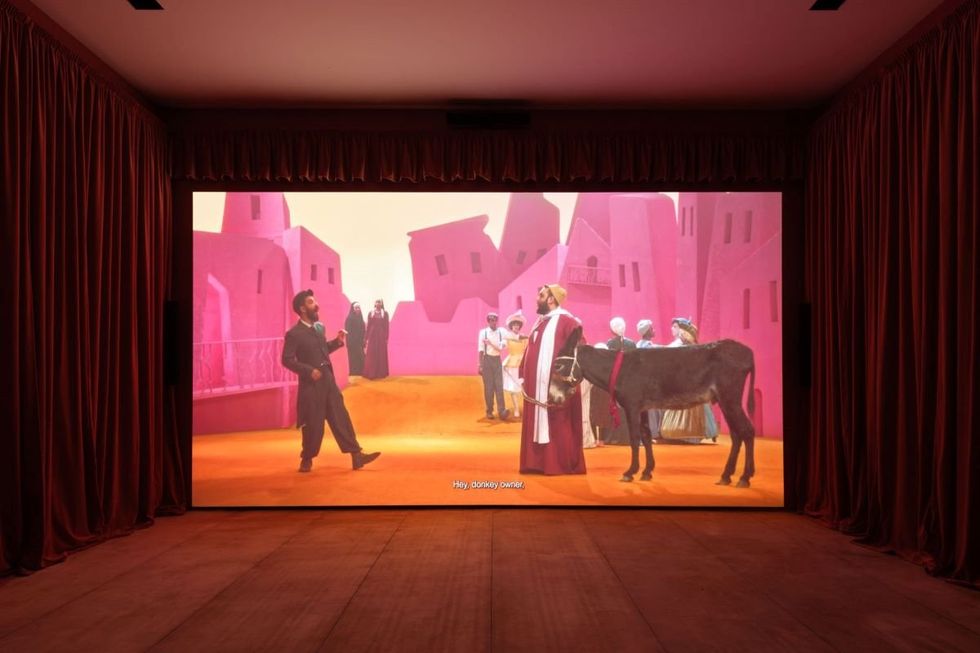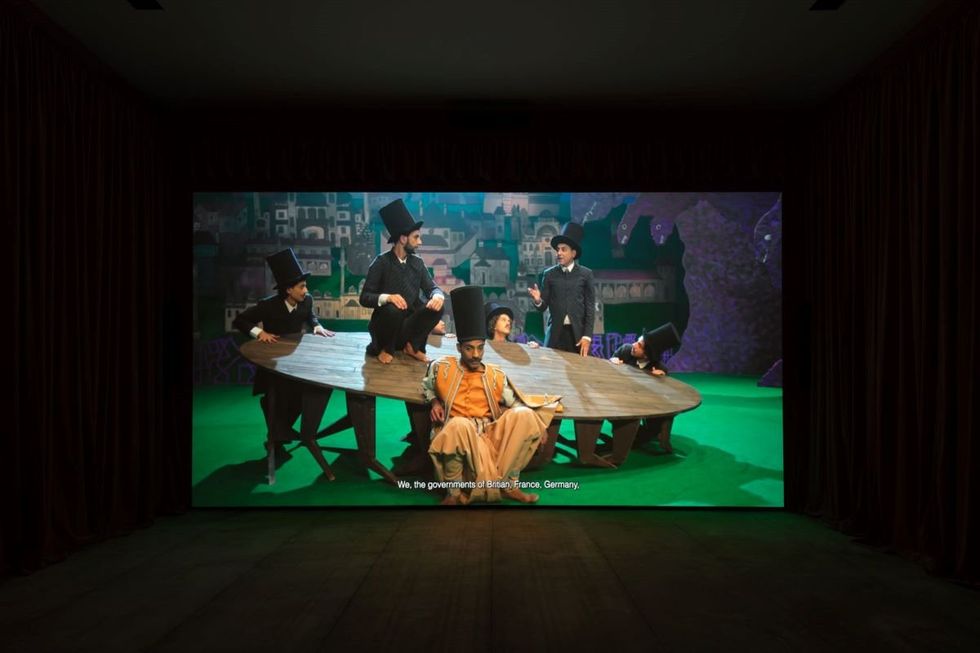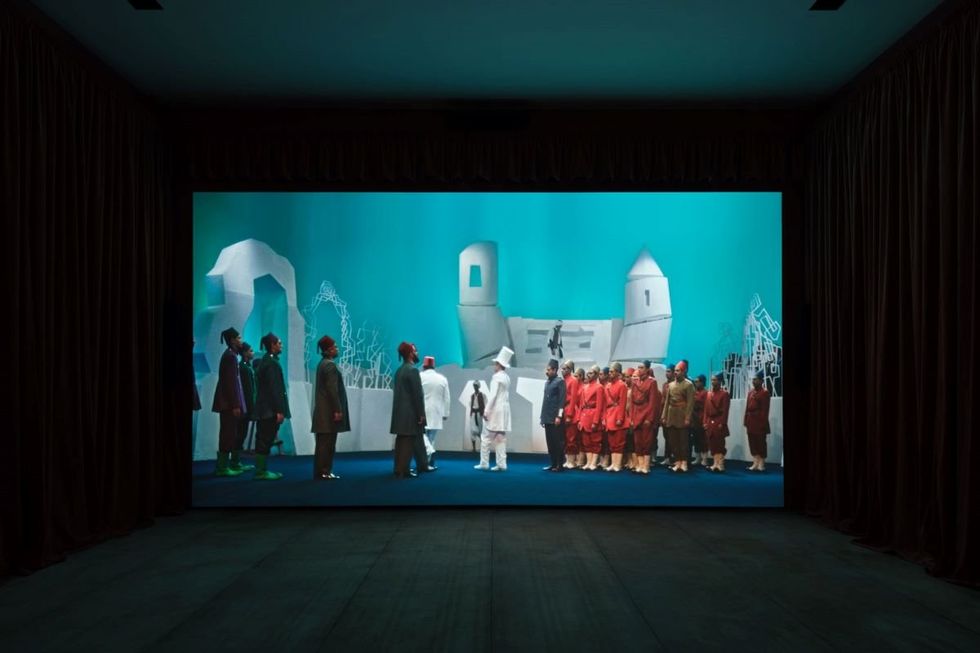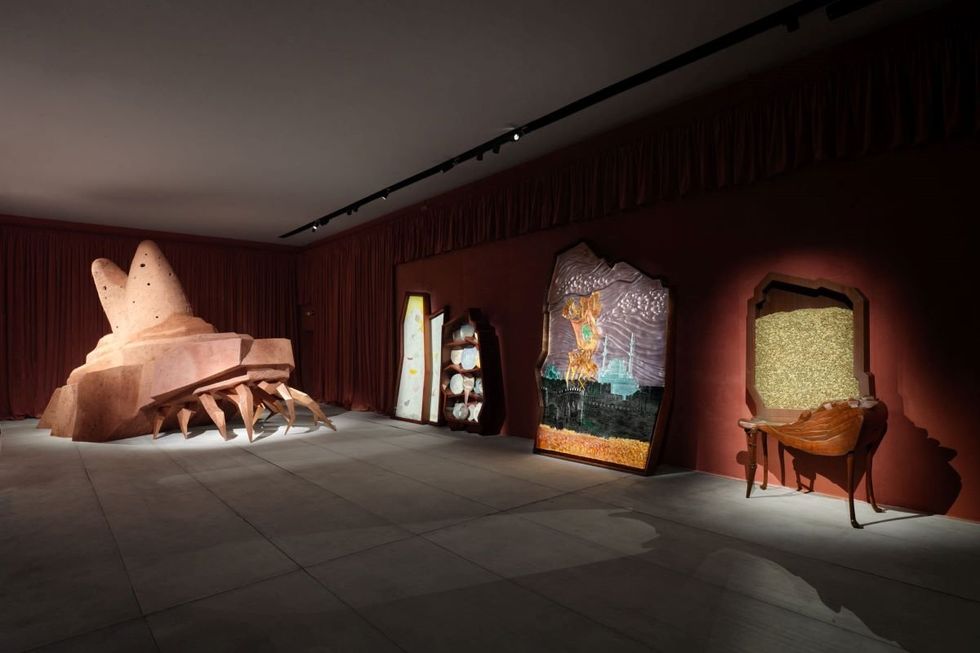Dress: Emily Eanae | Earrings: Stylist own | Shoes: Balenciaga.
Elsa Majimbo's Over Being a Comedian - and Wants You to Be, Too
Four years after becoming a viral social media sensation, many of her fans want to know where the “old Elsa” is. But Elsa Majimbo’s not bowing to anyone else’s expectations or pressure.
Elsa Majimbo is beaming.
Standing in the doorway of an old convent, she cuts a majestic figure – draped in a dramatic black, ankle-length coat, with a gravity defying Afro and gold jewelry shimmering in the blinding New York sunlight. On location to shoot the OkayAfrica digital cover, Majimbo is quietly enjoying a small break when suddenly cries of “Elsa!” fill the air.
A gaggle of school kids has seemingly appeared from nowhere, and they're now filling up the road outside the building. The pre-teens point and jostle each other as they try to get a better view of the 22-year-old Kenyan. “Elsa’s inside!” some shriek – and who can blame them for their excitement? After all, it’s not every day that a social media sensation shows up on your neighborhood doorstep. Majimbo looks on, unfazed by all the commotion, the bemused smile on her face suggests she has become accustomed to being at the center of a frenzy. As the youngsters grow louder, the scene playing out seems surreal – a 15-time chess champion catapulted to global fame and the attention of the likes of Beyoncé and Rihanna, thanks to her lo-fi videos shot during the pandemic lockdown – now driving a group of youngsters wild in a tucked away corner of Queens. Though in listening to Majimbo’s accounting for her meteoric rise, there is no place for randomness or luck in her life story. She believes it is all the work of God. “I’ve got Gen Alpha on my side,” she says, as she waves back at the raucous crowd, with a twinkle in her eye.
When the photoshoot resumes upstairs in a spartan room, gone is Majimbo’s playful demeanor and in its place is now a penetrating, steely gaze. She moves with ease and grace; cycling through different poses without any hint of uncertainty, while a cast of lighting techs, makeup artist and hair stylist all look on. That trademark Majimbo confidence is once again on full display.

Dress: Quine Li | Shoes: Victoria Beckham.
Photo by Adbi Ibrahim.
By now, anyone who has ever heard of Elsa Majimbo is familiar with her comic viral videos. The cheekily brazen ruminations of the-then 18-year-old brought much needed levity to millions who felt trapped in their surroundings, courtesy of Covid. Majimbo’s charm and well-timed laughter cemented her place in the hearts of many as a naturally gifted comedian. But these days, being labeled a comedian no longer works for Majimbo – as she makes plain in conversation; she now wants to be known as a model. No more eating potato chips on the bed, no more sunglasses perched awkwardly on her face. The comedy has gone. “That’s a phase of my life that was there, but I’ve left it behind,” Majimbo later explains over lunch at her Williamsburg hotel. “That was just to get me off the ground. We’re off the ground now,” she adds.
Her life has certainly ascended to dizzying heights, since the pandemic ended. The fame and fortune she openly longed for in those videos have arrived, and she is now living in Los Angeles. Her social media feed is a catalog of micro-outfits, shopping sprees and glamorous events. There have also been features in Forbes Magazine, and covers for Teen Vogue and GQ South Africa. In 2022, she signed to IMG Models and WME, and since then has appeared in campaigns for Valentino and Coach. These days her online videos showcase her applying generous amounts of body oil and perfume, while recounting an anecdote about her new fabulous life. Though the change may be jarring to some, Majimbo never hid her aspirational desires, “I told everyone, ‘Love "broke Elsa" while you can, she’s not coming back.’”

Coat: ITA The Label | Shoes: Saint Laurent | Flower anklet: Stylist's own.
Photo by Abdi Ibrahim.
Hours later, standing tall in an eye-popping royal blue gown, she completes another round of poses. When she is done, Majimbo takes a step back and claps her hands in glee. She studies the images on the photographer’s monitor, clearly liking what she sees. “I knew what I came to do, and I did it!” she gleams, before triumphantly strutting off to her next outfit change. In many ways, the location for her cover shoot – a former convent with crucifixes adorning every room and the occasional light fixture with the invocation, “Bless this house, O Lord we pray/Make it safe by night and day” – is a fitting milieu for Majimbo, the second youngest in a family of four. She makes no secret of her Christian faith and how many of the major life decisions she has made have all been predicated on her firm belief in the divine – like dropping out of school to pursue the fickle path of becoming a content creator. “I'm a testimony,” she says. “God brought me here.”
And she is going to need that faith for what lies ahead because what Majimbo is attempting to pull off in the world of modeling and high fashion is a far more difficult proposition. Countless other models have tried and failed to attain significant and lasting success in an industry renowned for its racism and misogyny. The uncertainties abound, and they include making and keeping high profile friends, as Majimbo’s very public falling out with supermodel Naomi Campbell clearly demonstrated. Although she is reticent to talk about this any further, she is outspoken about her experience navigating the world of celebrity and Black Hollywood at large. “I think for me one of the biggest shocks is white people have actually really been there for me,” she says. “White people have given me a lot of opportunities; they’ve really stuck their necks out for me. And I expected the opposite. Most of the pitfalls I’ve gotten in my career have been due to Black people, which is so disheartening. Because, I was like, ‘Oh, you know, Black Hollywood, Black Hollywood, it's all about each other.' But not everything is what it seems."

Dress: Lilach Porges | Shoes: Rochas.
Photo by Adbi Ibrahim.
There have been hurtful attacks from her fellow Kenyans. The online blows came quickly, as she garnered more and more public attention in those early days. The commentary about her took a nasty turn and she transitioned from being a charmingly irreverent dilettante to the subject of sustained misogynoir in her home country. The backlash would eventually prompt her to leave Nairobi and head to South Africa. “It was middle aged men and women coming to attack me – at the time I was 18,” she recalls. Four years on and the online criticism continues, but Majimbo is adamant that she is now totally unbothered by it all, “When I’m in Kenya everyone I meet in person: ‘Oh my God, I’m your biggest fan,’” she retorts sardonically.
In fact, she now appears to delight in taunting her critics with details of her shopping excursions and international shopping sprees, “Why would what User299780 say matter to me?” she responds to the question of whether any of the blows hit. “I don’t even look at my comments because I don’t have the time. I have parties to go to, lunches to go to, flights to catch…The comments you see online, that’s just what they are, comments.” That may be so, but she isn’t above oiling her arms and making a video to address them. Is it all part of some kind of plan to stay relevant? Remaining at the center of attention would ultimately benefit the growing bank account she is always talking about.
Despite all the flaunting and her near constant talk about having money, Majimbo says she doesn’t fear not having any. “Even when things are going to shit, I’ve never been financially insecure,” she says, crediting her parents for all the money she has amassed so far. They instilled in her a sense of financial literacy and urged her to get into the Kenyan property market. “I know no matter what happens, I'm not going broke. It's a fantastic feeling.”

Bodysuit: Quine Li | Shoes: Christian Dior.
Photo by Abdi Ibrahim.
In almost the same breath, her talk of earthly pursuits gives way to exhortations of religious faith. “Being spiritual has helped me stand up to people, especially those who have control and power,” she says, steadfastly. “I serve a living God, you’re not above Him.” But before long, her unflinching self-confidence returns, “No one from where I came from has been able to do what I have done, in the amount of time, [and] how I’ve done it. The only other Kenyan in Hollywood is Lupita [Nyong’o] – and even she had to do two decades of work to get where she is," she breezily proclaims. In reality, it’s only been a decade since the Oscar winner sprung into the spotlight, just shortly after graduating from Yale’s School of Drama. But who needs facts when there’s such outsized confidence at play?
Majimbo wants to be a force in the world of modeling and entertainment, which perhaps explains what some might describe as an unlikely friendship between herself and Steve Harvey, whom she refers to as her mentor. She is clearly in awe of how Harvey has successfully translated his comedy prowess into a media empire. “The way he takes ownership of his content, that's how I want to have ownership of my content,” she reflects. That goal extends to projects in front of and behind the camera, with Majimbo sharing that modeling aside, she is also exploring opportunities in production and acting, following the release of the self titled documentary short, Elsa, back in 2023. This time around she is clearly going after more, “[I don’t want] 'Oh, look at Elsa’s show,' but in reality it's not Elsa’s show, Elsa’s getting paid least on the show,” she astutely explains. “I just don't want to be in a position like that. If I say we're doing this, I'm gonna own some of it.”
There is a keen sense of cognizance that her sustained trajectory of wins is not guaranteed – perhaps Majimbo may stop short of any runway work or fail to achieve the success she envisioned in working in film and TV. But she says that as long as she remains in control, however, she will be at peace with the outcome. “If it's meant for me it will find me – if it’s not, no problem. Maybe I'll end up a lawyer,” she muses, briefly wincing at the thought. “Oh, God forbid,” she says, before once again letting out that infectious laugh.
Additional reporting by Shamira Ibrahim.
Credits:
Abdi Ibrahim - Photographer @abshoots
Tiffany Bloomfield - Executive Producer/Artist Rep @insidetheglow
Karely Pérez-Cruz - Producer @peluaproductions
Fallou Seck - 1st Photo Assistant @myowndad
Wendell Cole - 2nd Photo Assistant @wendellcole
Haren Mehta - Digital Tech @harenmehta
Tyler Okuns - Wardrobe Stylist @tyleeresosa
Rose Grace - Makeup Artist @rosegracemua
Rachel Polycarpe - Hair Artist @rachelpolycarpe
- Watch Lupita Nyong'o's Interview on 'The Daily Show With Trevor Noah' ›
- This Kenyan Comedian Is Laughing Her Way To Top Brand Collaborations ›
- Kenya's Elsa Majimbo Bags 2020 E! People’s Choice Award ›




